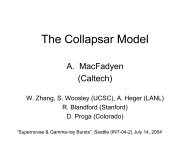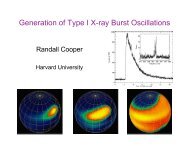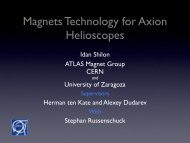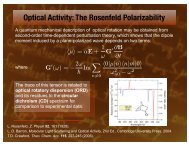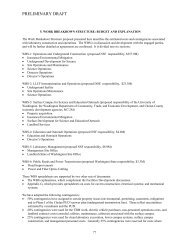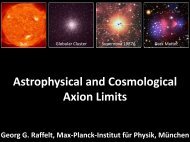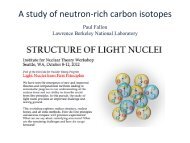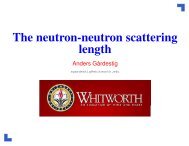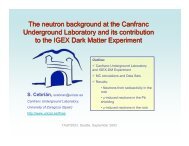MuLan– a precision measurement of the positive muon lifetime and ...
MuLan– a precision measurement of the positive muon lifetime and ...
MuLan– a precision measurement of the positive muon lifetime and ...
Create successful ePaper yourself
Turn your PDF publications into a flip-book with our unique Google optimized e-Paper software.
<strong>MuLan–</strong> a <strong>precision</strong> <strong>measurement</strong> <strong>of</strong> <strong>the</strong><br />
<strong>positive</strong> <strong>muon</strong> <strong>lifetime</strong> <strong>and</strong> determination <strong>of</strong><br />
<strong>the</strong> Fermi constant.<br />
Tim Gorringe, Univ. <strong>of</strong> Kentucky,<br />
on behalf <strong>of</strong> MuLan Collaboration.<br />
Boston Univ. 5 , Groningen Univ 7 , James Madison Univ 6 ,<br />
TRIUMF 3 , Univ. <strong>of</strong> California Berkeley 2 , Univ. <strong>of</strong> Illinois<br />
at Urbana-Champaign 1 , Univ. <strong>of</strong> Kentucky 4 .
Overview<br />
● remarks on <strong>the</strong> <strong>muon</strong> <strong>lifetime</strong>, <strong>the</strong> Fermi<br />
constant <strong>and</strong> electroweak interactions<br />
● MuLan setup<br />
● MuLan systematics<br />
● 2004 run results<br />
● 2006/7 run progress
<strong>muon</strong> <strong>lifetime</strong>, Fermi constant <strong>and</strong><br />
electroweak interactions
Electroweak interactions ...<br />
α (±0.4ppb), G F (±10ppm),<br />
<strong>and</strong> M Z (±23ppm).<br />
predictive power <strong>of</strong><br />
electroweak interactions<br />
between quarks <strong>and</strong> leptons<br />
at tree level: SM relations to bare couplings <strong>and</strong> masses<br />
4 =g g ' / g 2 g' 2 , G F =2 / 2<br />
M Z=g 2 g' 2 , M W =g <br />
beyond tree level: quantum loops dress relations between bare<br />
couplings <strong>and</strong> masses<br />
heavy qq pairs + Higg's loops + SUSY loops? ...
μ<br />
μ<br />
Electroweak interactions ...<br />
W<br />
G F<br />
1<br />
<br />
Δq contains QED, QCD loops<br />
g<br />
g<br />
e<br />
ν e<br />
ν μ<br />
ν μ<br />
ν e<br />
e<br />
= G 2 5<br />
F m<br />
1q<br />
2<br />
192<br />
G F<br />
2<br />
Δr contains electroweak loops<br />
H<br />
g2<br />
= 2<br />
8 M W<br />
1r<br />
+ ...<br />
+ ...
Brief history <strong>of</strong> <strong>the</strong> Fermi Constant<br />
1934<br />
Fermi's four-fermion<br />
interaction <strong>of</strong> β-decay<br />
50's<br />
V-A structure <strong>of</strong><br />
weak interactions<br />
Universality <strong>of</strong><br />
weak interactions<br />
60's<br />
Unified <strong>the</strong>ory <strong>and</strong><br />
electroweak interactions<br />
70-80's<br />
Discovery <strong>of</strong> neutral currents,<br />
W,Z bosons<br />
LHC era<br />
higher symmetries?
Brief history <strong>of</strong> <strong>muon</strong> <strong>lifetime</strong><br />
τ = 2.19703(4) µs (PDG2002)<br />
one-by-one exptl limit,<br />
one-loop QED limit<br />
2002PDG world<br />
average
MuLan setup
Paul Scherrer Institute – proton<br />
accelerator complex
Paul Scherrer Institute – proton<br />
accelerator complex<br />
590 MeV, 2.0 mA<br />
proton cyclotron<br />
graphite target<br />
stations, π's, μ's<br />
μLan situated<br />
on πE3 beamline
principle <strong>of</strong> accumulating µ + 's <strong>and</strong> measuring e + 's<br />
µ +<br />
kicker<br />
on<br />
<strong>of</strong>f<br />
ball<br />
tgt<br />
e +
µLan method <strong>of</strong> accumulating µ + 's <strong>and</strong><br />
measuring e + 's<br />
beam on beam <strong>of</strong>f<br />
beam monitor<br />
µLan ball<br />
(FAST collaboration use alternative method)
wire chamber<br />
μ<br />
μLAN Setup.<br />
e<br />
scintillator tiles<br />
stopping target
a tile ....<br />
a house ..<br />
μLAN Setup<br />
<strong>the</strong> ball ...
μLAN Setup
MuLan systematics – pulse pileup<br />
“Minimize by segmentation <strong>and</strong> digitization<br />
– <strong>the</strong>n measure very carefully.”
digitize<br />
Δt = artifical deadtime<br />
±Δt = coincidence window<br />
fit<br />
Δt<br />
Data<br />
Analysis<br />
histogram<br />
counts counts<br />
time
digitize<br />
Δt = artifical deadtime<br />
±Δt = coincidence window<br />
“Double coincidence” pile-up,<br />
-Re -2t/τ distortion<br />
fit<br />
Δt<br />
histogram<br />
counts<br />
time
i.o<br />
beam<br />
on<br />
shadow<br />
window<br />
counts<br />
true<br />
hits, e -t/τ<br />
time<br />
“Double coincidence” correction,<br />
shadow windowing<br />
beam<br />
on<br />
counts<br />
Δt<br />
measured<br />
hits,e -t/<br />
time<br />
beam<br />
on<br />
= +<br />
τ Re-2t/τ counts<br />
shadow<br />
hits, Re -2t/τ<br />
time
2004 data pile-up correction<br />
uncorrected<br />
spectrum<br />
shadow<br />
spectrum<br />
( τ – τ ) [ppm]<br />
<strong>of</strong>fset<br />
Measured τ vs artifical deadtime<br />
uncorrected<br />
<strong>lifetime</strong><br />
corrected<br />
<strong>lifetime</strong><br />
artifical deadtime [ns]
MuLan systematics – μSR<br />
“Minimize by dephasing, geometry <strong>and</strong> target choices<br />
– <strong>the</strong>n measure very carefully.”
ν<br />
π +<br />
parity violating<br />
pion decay<br />
μ +<br />
beamline<br />
μ +<br />
θ<br />
parity violating<br />
<strong>muon</strong> decay<br />
e +
transverse field μSR longitudinal field μSR<br />
μ μ<br />
TFµSR effect is minimized<br />
by dephasing.<br />
LFµSR effect is minimized<br />
by geometry.
1) dephasing<br />
2) targets<br />
beam on<br />
1 2 3 4<br />
a) μ + in B int =5000G<br />
ferromagnetic Fe-Cr-Ni alloy<br />
3) geometry<br />
μ<br />
μ<br />
B<br />
tgt tgt<br />
FF<br />
TF μSR<br />
3<br />
4<br />
1<br />
2<br />
b) μ + e in B ext =100G<br />
quartz (SiO 2 )<br />
F+B<br />
F-B
Dedicated quartz TF μSR <strong>measurement</strong><br />
showing<br />
precession signal.<br />
~500 ppm precession signal in<br />
quartz production data.<br />
Dedicated quartz LF μSR <strong>measurement</strong><br />
showing<br />
longitudinal relaxation<br />
±50 ppm <strong>lifetime</strong> shift in<br />
quartz production data.
MuLan systematics – errant <strong>muon</strong>s<br />
“put <strong>the</strong> target in <strong>the</strong> beampipe<br />
– <strong>the</strong>n measure very carefully.”
eam on beam <strong>of</strong>f<br />
~10 -3 beam extinction
plastic scintillator beam pr<strong>of</strong>ile<br />
at ~1m upstream <strong>of</strong> target position<br />
beampipe<br />
radius<br />
MuLan systematics –<br />
o<strong>the</strong>r systematics include instrumental stabilities<br />
(timing, gain, pedestal, etc) over <strong>the</strong> <strong>measurement</strong> period
MuLan results – 2004 run<br />
“First results.”<br />
- in-air ferromagnetic target<br />
- multihit TDC readout<br />
- ~10 10 decays
2004 results - <strong>the</strong> fit
2004 results – <strong>the</strong> numbers<br />
source uncertainty<br />
statistical 9.6 ppm<br />
systematic 5.0 ppm<br />
total 11 ppm<br />
time-errant <strong>muon</strong>s 3.5 ppm<br />
space-errant <strong>muon</strong>s 2 ppm<br />
pulse pile-up 2 ppm<br />
instrumental linearites 2.5 ppm<br />
τ μ (MuLan) =<br />
2.197013(21)(11) μs
11ppm<br />
16ppm
MuLan progress – 06,07 runs<br />
“Part-per-million goal.”<br />
- improved beam extinction<br />
- in-vacuum targets<br />
- 500 MHz waveform digitizers
2006<br />
ferromagnetic alloy<br />
2007<br />
quartz crystal
10 12 decays -> ~100 TB raw data -> ~10 5 CPU hours<br />
underst<strong>and</strong>ing systematics including ~100 ppm effects <strong>of</strong><br />
pile-up <strong>and</strong> µSR to sub-ppm levels<br />
e.g<br />
+ + ...
Goal 1ppm!
muCap experiment – negative <strong>muon</strong> <strong>lifetime</strong><br />
in 1% LH 2 density, 300 K, ultra-pure hydrogen<br />
−1 −1<br />
p n , . D= − p<br />
g p coupling ,QCD symmetries<br />
muSun experiment – negative <strong>muon</strong> <strong>lifetime</strong><br />
in 5% LD 2 density, 30 K, ultra-pure deuterium<br />
d n n , D= .<br />
−1 − d<br />
−1<br />
astro− phys , neutrino− phys.
muCap experiment – negative <strong>muon</strong> <strong>lifetime</strong><br />
in 1% LH 2 density, 300 K, ultra-pure hydrogen<br />
muSun experiment – negative <strong>muon</strong> <strong>lifetime</strong><br />
in 5% LD 2 density, 30 K, ultra-pure deuterium
muCap experiment – negative <strong>muon</strong> <strong>lifetime</strong><br />
in 1% LH 2 density, 300 K, ultra-pure hydrogen<br />
muSun experiment – negative <strong>muon</strong> <strong>lifetime</strong><br />
in 5% LD 2 density, 30 K, ultra-pure deuterium
muCap experiment – negative <strong>muon</strong> <strong>lifetime</strong><br />
in 1% LH 2 density, 300 K, ultra-pure hydrogen<br />
−1 −1 −1<br />
p n ; . S= − p=725±17<br />
s ; g p=7.3±1.1<br />
muSun experiment – negative <strong>muon</strong> <strong>lifetime</strong><br />
in 5% LD 2 density, 30 K, ultra-pure deuterium<br />
−1 −1 −1<br />
d n n ; . D= − d=?<br />
s ; astro ,neutrino



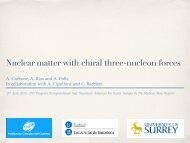
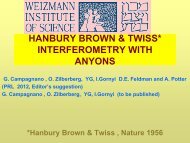
![Lecture 3 [pdf] - Institute for Nuclear Theory](https://img.yumpu.com/14762808/1/190x143/lecture-3-pdf-institute-for-nuclear-theory.jpg?quality=85)
